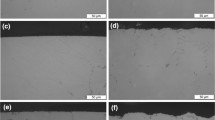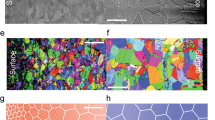Abstract
The surface topography and microstructure of a 9%Cr steel are shown to drastically impact its interaction with molten nitrate salt at 550 °C. In particular, surfaces with scale-invariant topography are found to be more vulnerable to attack by molten salt. This vulnerability is associated with the percolation of molten salt through oxide layers, providing new insights into the interaction mechanism. Scale-invariant topography is found to interact with scale-invariant percolation geometry, leading to accelerated attack. Microstructural modification introduced through prior heat treatment can also impact the extent of attack through mechanisms associated with microstructural strain. It is found that the material-salt interaction involves greater complexity than conventionally believed as it is the result of two transport phenomena, namely elemental diffusion and percolation of salt. Incorporating fractal geometry concepts provides a more realistic estimation of molten salt attack since these facilitate better physical correlation with the ongoing transport phenomena.








Similar content being viewed by others
References
IAEA-TECDOC-1696, “Challenges Related to the Use of Liquid Metal and Molten Salt Coolants in Advanced Reactors” (IAEA, 2013), https://www.iaea.org/publications/8942/challenges-related-to-the-use-of-liquid-metal-and-molten-salt-coolants-in-advanced-reactors. Accessed 10 April 2022.
T. Sugawara, Ann. Nucl. Energy. https://doi.org/10.1016/j.anucene.2020.107818 (2020).
M. Allibert,M. Aufiero,M. Brovchenko, S. Delpech, V. Ghetta, D. Heuer, A. Laureau,E. Merle-Lucotte1, Molten salt fast reactors, ed. I.L. Pioro (Woodhead, UK, 2016) p. 157. https://doi.org/10.1016/B978-0-08-100149-3.00007-0
B. Raj, Sadhana. https://doi.org/10.1007/BF02703293 (2002).
C. Cabet, F. Dalle, E. Gaganidze, J. Henry, and H. Tanigawa, J. Nucl. Mater. https://doi.org/10.1016/j.jnucmat.2019.05.0580022-3115 (2019).
S.C. Chetal, P. Chellapandi, P. Puthiyavinayagam, S. Raghupathy, V. Balasubramaniyan, P. Selvaraj, P. Mohanakrishnan, and B. Raj, Energy Procedia. https://doi.org/10.1016/j.egypro.2011.06.009 (2011).
C. Cabet, F. Rouillard, Corrosion phenomena induced by gases in Generation IV nuclear reactors, ed. P. Yvon (Woodhead, UK, 2017) p. 75.
K. Aoto, N. Uto, Y. Sakamoto, T. Ito, M. Toda, and S. Kotake, J. Nucl. Sci. Technol. https://doi.org/10.1080/18811248.2011.9711720 (2011).
R.W. Bradshaw, S.H. Goods, Corrosion of alloys and metals by molten nitrates,ed. C.A.C. Sequeira (TransTech Publications, USA, 2003) p. 117.
S.H. Goods, R.W. Bradshaw, M.J. Clift, D.R. Boehme, “The effect of silicon on the corrosion characteristics of 2 1/4Cr-1Mo steel in molten nitrate salt” SANDIA report: SAND 97–8269, 1997.
J. Wang, S. Lu, L. Rong, and D. Lia, J. Nucl. Mater. https://doi.org/10.1016/j.jnucmat.2015.11.055 (2015).
R.K. Gupta, R.K.S. Raman, and C.C. Koch, J. Mater. Sci. https://doi.org/10.1007/s10853-012-6529-5 (2012).
S. Chen, X. Jin, and L. Rong, Oxid. Met. https://doi.org/10.1007/s11085-015-9596-6 (2015).
E.K. Asare, Y. Zeng, and J.R. Kish, Can. Metall. Q. https://doi.org/10.1080/00084433.2021.2014711 (2021).
P. Kondaiah, and R. Pitchumani, Sol. Energy Mater. Sol. Cells. https://doi.org/10.1016/j.solmat.2021.111281 (2021).
Y. Zhang, S.-W. Ryu, C. Yerino, B. Leung, Q. Sun, Q. Song, H. Cao, and J. Han, Phys. Stat. Solidi. B. https://doi.org/10.1002/pssb.200983650 (2010).
S.K. Giri, A. Durgaprasad, K.V. Manikrishna, C.R. Anoop, S. Kundu, and I. Samajdar, Philos. Mag. https://doi.org/10.1080/14786435.2018.1552030 (2018).
G. Krauss, Steel Res. Int. https://doi.org/10.1002/srin.201700038 (2017).
A.M. Selvam, Fractals. https://doi.org/10.1142/S0218348X09004272 (2009).
B. Aashranth, G. Shankar, M.A. Davinci, D. Samantaray, U. Borah, and S. Suwas, J. Mater. Res. https://doi.org/10.1557/s43578-021-00141-5 (2021).
A. Bonk, M. Braun, A. Hanke, J. Forstner, D. Rückle, S. Kaesche, V.A. Sotz, and T. Bauer, AIP Conf. Proc. https://doi.org/10.1063/1.5067097 (2018).
F. Morin, G. Beranger, and P. Lacombe, Oxid. Met. https://doi.org/10.1007/BF00612507 (1972).
A.S. Khanna, High temperature oxidation and corrosion, (ASM International, Materials Park OH, 2002), pp. 72–120.
Y. Khaluf, E. Ferrante, P. Simoens, and C. Huepe, J. R. Soc. Interface. https://doi.org/10.1098/rsif.2017.0662 (2017).
J.W. Slusser, J.B. Titcomb, M.T. Heffelfinger, and B.R. Dunbobbin, JOM. https://doi.org/10.1007/BF03259692 (1985).
A. Kruizenga, and D. Gill, Energy Procedia. https://doi.org/10.1016/j.egypro.2014.03.095 (2014).
A. Aguero, P. Audigie, S. Rodriguez, V. Encinas-Sanchez, and M.T. de Miguel, AIP Conf. Proc. https://doi.org/10.1063/1.5067095 (2018).
A.S. Dorcheh, and M.C. Galetz, Sol. Energy. Mater. Sol. Cells. https://doi.org/10.1016/j.solmat.2015.11.024 (2016).
U. Nithiyanantham, Y. Grosu, L. Gonsalez-Fernandez, A. Zaki, J.M. Igartua, and A. Faik, Sol. Energy. https://doi.org/10.1016/j.solener.2019.07.050 (2019).
S. Yasir, J.L. Endrino, E. Guillen, and A.I. Aria, Emergent. Mater. https://doi.org/10.1007/s42247-021-00334-y (2021).
A. Aryanfar, W. Goddard III., and J. Marian, Corr. Sci. https://doi.org/10.1016/j.corsci.2019.06.013 (2019).
R.M. Bradley, P.N. Strenski, and J.-M. Debierre, Phys. Rev. B. https://doi.org/10.1103/PhysRevB.44.76 (1991).
J. Zierenberg, N. Fricke, M. Marenz, F.P. Spitzner, V. Blavatska, and W. Janke, Phys. Rev. E. https://doi.org/10.1103/PhysRevE.96.062125 (2017).
B. Ma, D. Shin, and D. Banerjee, J. Energy Storage. https://doi.org/10.1016/j.est.2021.102278 (2021).
S. Bell, D. Stoker, G. Will, and T. Steinberg, AIP Conf. Proc. https://doi.org/10.1063/1.5117720 (2019).
J.D. Robson, Metall. Mater. Trans. A. https://doi.org/10.1007/s11661-020-05960-5 (2020).
S. Morito, J. Nishikawa, and T. Maki, ISIJ Int. https://doi.org/10.2355/isijinternational.43.1475 (2003).
M. Shamsujjoha, Mater. Sci. Eng. A. https://doi.org/10.1016/j.msea.2020.139039 (2020).
M. Legros, G. Dehm, E. Arzt, and T.J. Balk, Science. https://doi.org/10.1126/science.1151771 (2008).
A.V. Kazantzis, Z.G. Chen, and J.Th.M. De Hosson, J. Mater. Sci. https://doi.org/10.1007/s10853-013-7555-7 (2013).
Author information
Authors and Affiliations
Corresponding author
Ethics declarations
Conflict of interest
The authors declare that there is no conflict of interest for this paper.
Additional information
Publisher's Note
Springer Nature remains neutral with regard to jurisdictional claims in published maps and institutional affiliations.
Appendix 1
Appendix 1
Optimization of Electrolytic Etching Parameters for Generating Morphological Texture
Oxalic acid is frequently used as an electrolytic etchant for both metallography and assessing the susceptibility of stainless steels to sensitization. The electrolytic etching process is versatile and lends itself to various applications. For instance, etching with 6 V can uniformly reveal the grain boundaries in stainless steels, but a 10 V etch generates a slightly porous surface in doped GaN.16 Analogous to voltage, etching time can alter the nature of a steel surface.15 A systematic study on the effect of etchant composition and etching time has been carried out for high Cr stainless steels,15 wherein the resultant surface was assessed for development of texture using the fractal dimension (described in Section “Surface Characterization by Roughness and Fractal Dimension”).
In the same manner, for a fixed etchant composition (10% oxalic acid-90% water), we have carried out a systematic variation of etching voltage and etching time for the 9%Cr steel used in this study. To this end, several dummy specimens were heat treated to generate the lath martensitic microstructure. Similar to the actual specimens used in this study, the heat treatment-induced oxide was removed using a 220-grit emery paper. The polished surfaces were subjected to room-temperature electrolytic etching in 10% oxalic acid, using different etching voltages and times. For each voltage–time combination, the resultant etched surface was measured using CLSM and its fractal dimension was measured in the manner described in Section “Surface Characterization by Roughness and Fractal Dimension.” The results of this experimentation are shown in Fig.
9.
It was found that low etching voltages (2 V) are inadequate to generate appreciable surface texture. Etching with 6 V resulted in a rapid increase in fractal dimension in 20 s, following which the surface texture remained essentially stable at ~ 2.74. On the other hand, etching with high voltage of 10 V resulted in the highest fractal dimension (~ 2.8) within just 20 s. However, this was immediately followed by a drop in fractal dimension. The drop was accompanied by large-scale removal of material from the surface, resulting in a relatively uniform surface. Due to the rapid changes in the surface during etching for ~ 20 s, the high voltage was deemed irreproducible and hence unsuitable. The optimal combination of high fractal dimension, stability and reproducibility was found to be 6 V etch for 30 s. This optimized condition was used for all experiments carried out in this study.
Rights and permissions
Springer Nature or its licensor (e.g. a society or other partner) holds exclusive rights to this article under a publishing agreement with the author(s) or other rightsholder(s); author self-archiving of the accepted manuscript version of this article is solely governed by the terms of such publishing agreement and applicable law.
About this article
Cite this article
Aashranth, B., Davinci, M.A. & Samantaray, D. Scale-Invariant Geometries Arising from the Interaction Between a 9%Cr Steel and Molten Nitrate Salt. JOM 75, 3136–3148 (2023). https://doi.org/10.1007/s11837-023-05844-0
Received:
Accepted:
Published:
Issue Date:
DOI: https://doi.org/10.1007/s11837-023-05844-0





